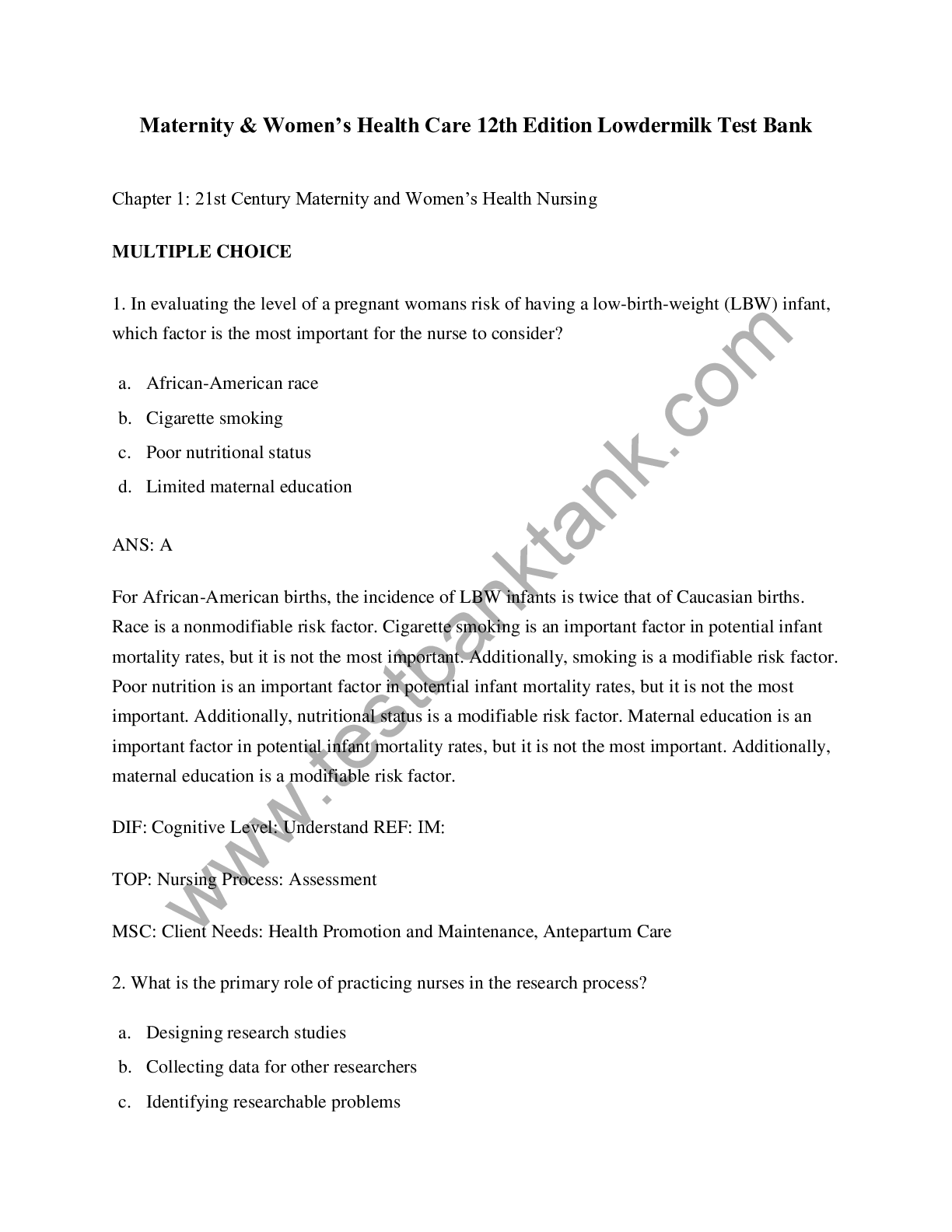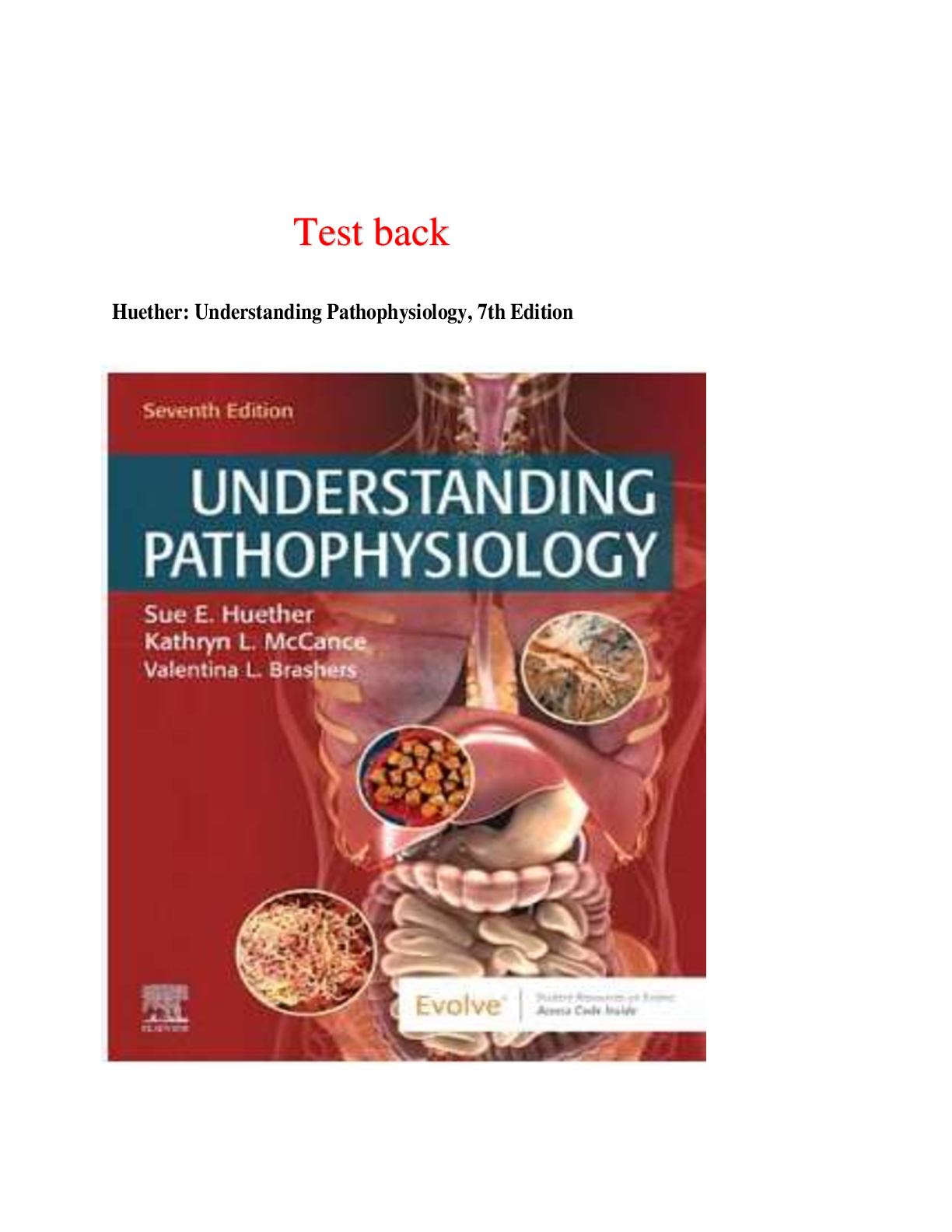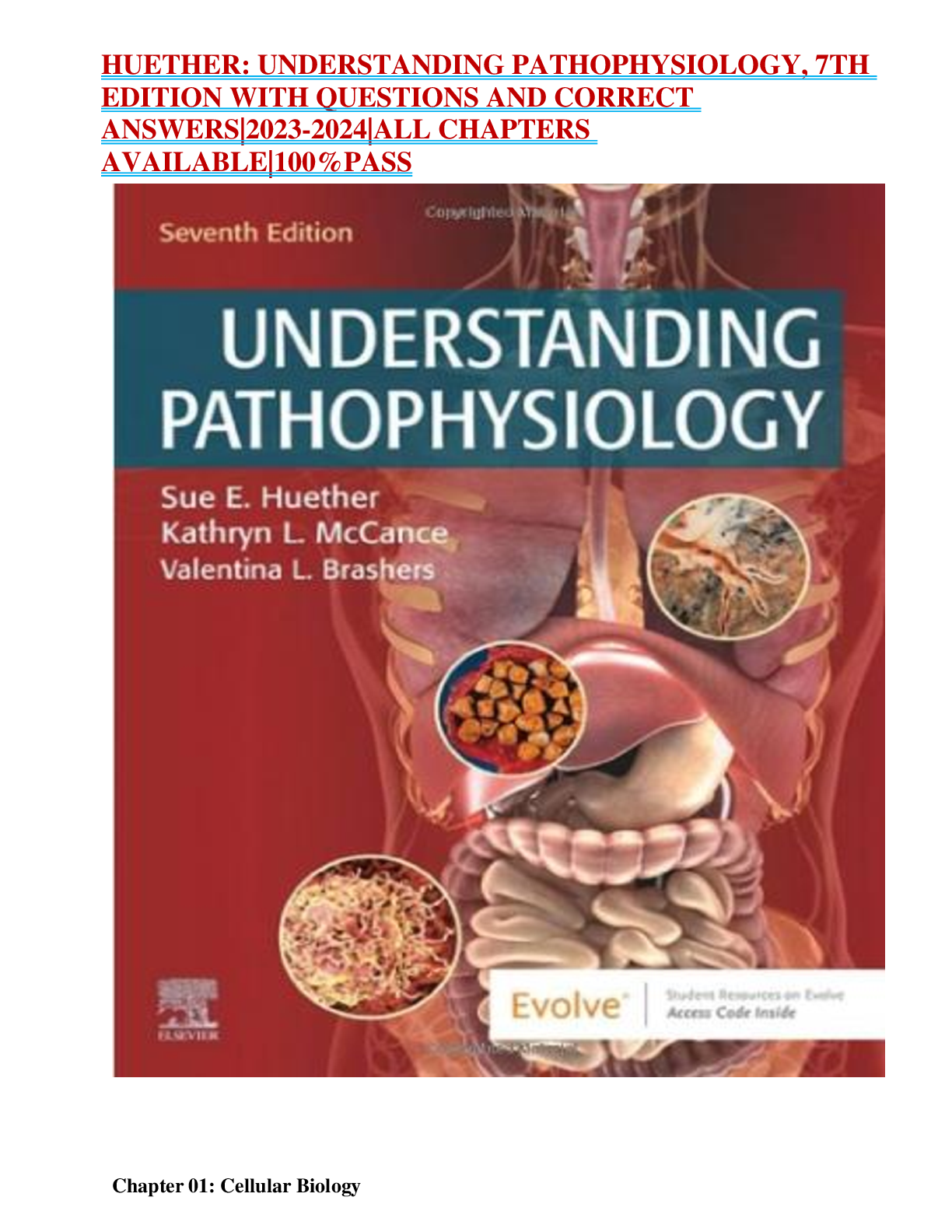*NURSING > EXAM > Chapter 01: Cellular Biology Huether: Understanding Pathophysiology, 7th Edition (All)
Chapter 01: Cellular Biology Huether: Understanding Pathophysiology, 7th Edition
Document Content and Description Below
Chapter 01: Cellular Biology Huether: Understanding Pathophysiology, 7th Edition MULTIPLE CHOICE 1. A student is observing a cell under the microscope. It is observed to have supercoiled DNA... with histones. Which of the following would also be observed by the student? a. A single circular chromosome b. A nucleus c. Free-floating nuclear material d. No organelles 2. A nurse is instructing the staff about cellular functions. Which cellular function is the nurse describing when an isolated cell absorbs oxygen and uses it to transform nutrients to energy? a. Metabolic absorption b. Communication c. Secretion d. Respiration 3. A eukaryotic cell is undergoing DNA replication. In which region of the cell would most of the genetic information be contained? a. Mitochondria b. Ribosome c. Nucleolus d. Nucleus cytoplasm 4. Which of the following can remove proteins attached to the cell’s bilayer by dissolving the layer itself? a. Peripheral membrane proteins b. Integral membrane proteins c. Glycoproteins d. Cell adhesion molecules 5. Which of the following can bind to plasma membrane receptors? a. Oxygen b. Ribosomes c. Amphipathic lipids d. Ligands 6. A nurse is reviewing a report from a patient with metastatic cancer. What alternation in the extracellular matrix would support the diagnosis of metastatic cancer? a. Decreased fibronectin b. Increased collagen c. Decreased elastin d. Increased glycoproteins 7. Which form of cell communication is used to relate to other cells in direct physical contact? a. Cell junction b. Gap junction c. Desmosome d. Tight junction 8. Pancreatic beta cells secrete insulin, which inhibits secretion of glucagon from neighboring alpha cells. This action is an example of which of the following signaling types? a. Paracrine b. Autocrine c. Neurohormonal d. Hormonal 9. In cellular metabolism, each enzyme has a high affinity for a: a. solute. b. substrate. c. receptor. d. ribosome. 10. An athlete runs a marathon, after which his muscles feel fatigued and unable to contract. The athlete asks the nurse why this happened. The nurse’s response is based on the knowledge that the problem is result of a deficiency of: a. GTP. b. AMP. c. ATP. d. GMP. . 11. Which phase of catabolism produces the most ATP? a. Digestion b. Glycolysis c. Oxidation d. Citric acid cycle 12. A nurse is teaching the staff about the phases of cellular catabolism. Which phases should the nurse include? a. Digestion, glycolysis, oxidation, and the citric acid cycle b. Diffusion, osmosis, and mediated transport c. S phase, G phase, and M phase d. Metabolic absorption, respiration, and excretion 13. A runner has depleted all the oxygen available for muscle energy. Which of the following will facilitate his continued muscle performance? a. Electron-transport chain b. Aerobic glycolysis c. Anaerobic glycolysis d. Oxidative phosphorylation 14. A faculty member asks a student to identify the appropriate term for the movement of a solute from an area of greater to lesser concentration. Which answer indicates the nursing student understood the teaching? a. Osmosis b. Diffusion c. Hydrostatic pressure d. Active transport ANS: B Diffusion is the movement of a solute molecule from an area of greater solute concentration to an area of lesser solute concentration through a permeable membrane. Osmosis is the movement of water across a semipermeable membrane from a region of higher water concentration to one of lower concentration. Hydrostatic pressure is the force of fluid against a cell membrane. In active transport, molecules move up a concentration gradient. 15. Which description accurately describes electrolytes? a. Small lipid-soluble molecules b. Large protein molecules c. Micronutrients used to produce ATP d. Electrically charged molecules 16. A nurse is reading a chart and sees the term oncotic pressure. The nurse recalls that oncotic pressure (colloid osmotic pressure) is determined by: a. the concentration of sodium. b. plasma proteins. c. hydrostatic pressure. d. the availability of membrane transporter proteins. 17. A patient has a body fluid of 300 mOsm/kg. This lab result is measuring: a. osmolality. b. osmolarity. c. osmotic pressure. d. oncotic pressure. 18. A nurse is discussing the movement of fluid across the arterial end of capillary membranes into the interstitial fluid surrounding the capillary. Which process of fluid movement is the nurse describing? a. Hydrostatic pressure b. Osmosis c. Diffusion d. Active transport 19. How are potassium and sodium transported across plasma membranes? a. By passive electrolyte channels b. By coupled channels c. By adenosine triphosphate enzyme (ATPase) d. By diffusion 20. The ion transporter that moves Na+ and Ca2+ simultaneously in the same direction is an example of which of the following types of transport? a. Biport b. Uniport c. Antiport d. Symport . 21. During which process are bacteria engulfed for ingestion? a. Endocytosis b. Pinocytosis c. Phagocytosis d. Exocytosis . 22. Some cancer drugs work during the cell cycle phase where nuclear and cytoplasmic divisions occur. What is this cell cycle phase called? a. G1 b. S c. M d. G2 . 23. Which causes the rapid change in the resting membrane potential that initiates an action potential? a. Potassium gates open, and potassium rushes into the cell, changing the membrane potential from negative to positive. b. Sodium gates open, and sodium rushes into the cell, changing the membrane potential from negative to positive. c. Sodium gates close, allowing potassium into the cell to change the membrane potential from positive toNnUegRaStivIeN. GKING.COM d. Potassium gates close, allowing sodium into the cell to change the membrane potential from positive to negative. 24. A cell is isolated, and electrophysiology studies reveal that the resting membrane potential is –70 mV. The predominant intracellular ion is Na+, and the predominant extracellular ion is K+. With voltage change, which of the following would result in an action potential? a. K+ rushing into the cell b. Na+ rushing into the cell c. Na+ rushing out of the cell d. K+ rushing out of the cell 25. A nurse teaching the staff about platelet-derived growth factor includes information that platelet-derived growth factor (PDGF) stimulates the production of: a. platelets. b. epidermal cells. c. connective tissue cells. d. fibroblast cells. . 26. The phase of the cell cycle during which the centromeres split and the sister chromatids are pulled apart is referred to as: a. anaphase. b. telophase. c. prophase. d. metaphase. ANS: A Anaphase begins when the centromeres split and the sister chromatids are pulled apart. During telophase, a new nuclear membrane is formed around each group of 46 chromosomes, the spindle fibers disappear, and the chromosomes begin to uncoil. During prophase, the first appearance of chromosomes occurs. Metaphase occurs when two centrioles located at opposite poles of the cell pull the chromosomes to opposite sides of the cell. 27. What is the role of cytokines in cell reproduction? a. Provide growth factor for tissue growth and development. b. Block progress of cell reproduction through the cell cycle. c. Restrain cell growth and development. d. Provide nutrients for cell NgrUoRwSthIaNndGdKeIvNelGop.mCeOntM. ANS: A Cytokines play a major role in the regulation of tissue growth and development but do not restrain it. Cytokines help overcome intracellular braking mechanisms that restrain cell growth and promote cell growth, but they do not provide nutrients. 28. A student is reviewing functions of the cell. The student would be correct in identifying a chief function of the nerve cell as: a. sensory interpretation. b. conductivity. c. maintenance of homeostasis. d. communication. ANS: B Conductivity, not sensory interpretation, homeostasis, or communication, is one of the eight chief functions of nerve cells. MULTIPLE RESPONSE 1. A nurse recalls that the basic types of tissues are: (Select all that apply.) a. nerve. b. epithelial. c. mucosal. d. connective. e. skeletal. f. muscle. ANS: A, B, D, F The basic tissue types include nerve, epithelial, connective, and muscle. Mucosal is a type of epithelial cell while skeletal is a type of connective tissue. 2. Characteristics of prokaryotes include which of the following? (Select all that apply.) a. They contain no organelles. b. Their nuclear material is not encased by a nuclear membrane. c. They contain a distinct nucleus. d. They contain histones. e. They contain a cellular membrane. ANS: A, B The prokaryotes lack a cellular membrane that encases nuclear material, thus they have no distinct nucleus; organelles and histones are also missing. NURSINGKING.COM [Show More]
Last updated: 2 years ago
Preview 1 out of 8 pages

Buy this document to get the full access instantly
Instant Download Access after purchase
Buy NowInstant download
We Accept:

Reviews( 0 )
$7.50
Can't find what you want? Try our AI powered Search
Document information
Connected school, study & course
About the document
Uploaded On
Jul 22, 2021
Number of pages
8
Written in
Additional information
This document has been written for:
Uploaded
Jul 22, 2021
Downloads
0
Views
70








.png)

.png)




